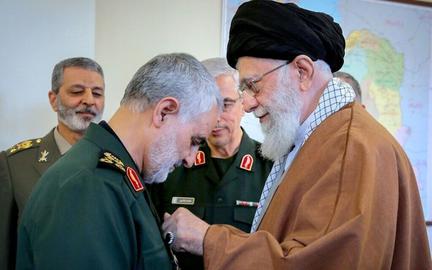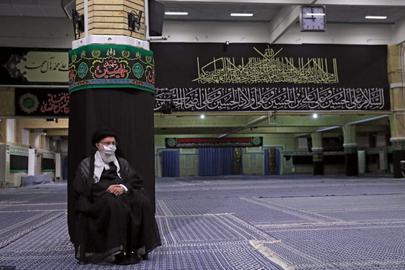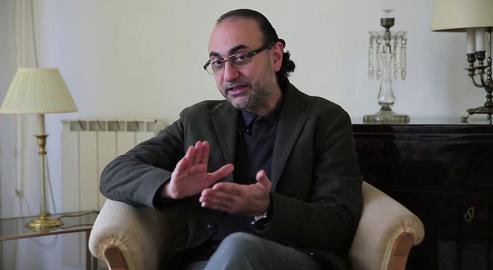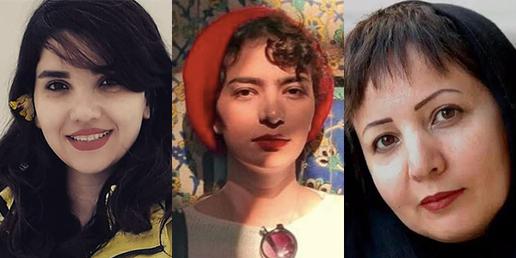In George Orwell’s seminal allegory Animal Farm, the protagonists want nothing more than to get rid of their human masters: bipeds who, the animals believe, are exploiting them by allowing them just enough food to just survive while grabbing the rest for themselves. So they rise up, drive the farmer off the land, and put the pigs of the farm in charge.
Among the furry and feathered cast is a donkey named Benjamin, who even after the revolt continues to work just as hard as before. Benjamin is indifferent to the revolution and, when asked, will only say: “I work. I just work. Donkeys live a long time. None of you has ever seen a dead donkey."
Benjamin’s worldview was encapsulated in the instructions issued by the Supreme Leader of the Islamic Republic of Iran to his people last week. “Work and work tirelessly, in the style of Haj Ghasem,” he said – Ghasem here referring to General Ghasem Soleimani, who was killed by an American drone in January.
***
On Monday, October 12, Ali Khamenei delivered a remote speech via videolink to graduates of the Iranian military academy. Both the form and the content of his speech raised eyebrows at a time when Iranians are dying left, right and center from Covid-19 and the speaker was perhaps the only person in the Islamic Republic of Iran to be fully insulated from the disease. Although the bulk of Khamenei’s speech revolved around “national power”, “security”, “economy” and “cultural invasion”, his only advice to his audience in the face of all this was : Work!
“Management must be strong, must be active, must be tireless,” Khamenei intoned. “Wherever we witness these qualities — tirelessness, energy and vivacity — we see that the work has progressed, and wherever these qualities are not present at all times, problems arise... Officials must strike out, must not tire, and must pursue their tasks without interruption. Only then, God willing, change will take place.”
Khamenei went on to invoke the late General Ghasem Soleimani as the embodiment of the values he wanted to see. This had some precedent. Back in the spring of 2019 the Supreme Leader had also said: “The economic war needs to follow Haj Ghasem’s example... The country’s economic problems will not be solved with laziness, lethargy and low motivation. The work must be done in the style of a jihad. Jihadi management must be used to solve economic problems.”
Khamenei had used the term “tireless” in the past as well, in reference to Mahmoud Ahmadinejad. At a meeting with cabinet ministers in the aftermath of the disputed 2009 presidential election, when, for all practical purposes, Ahmadinejad was appointed president of the Islamic Republic, Khamenei proclaimed: “Our president is truly energetic and tireless. Keeping up with him is hard work; God help you to keep up and achieve your goals. He works very hard and is energetic as well, though he may not appear so.”
Of course, in those days, Khamenei could scarcely imagine that one day this dauntless individual he had so praised would stand against him, throw tantrums and, at the end of his term, rail against the Islamic Republic regime from the rooftops. Ahmadinejad was not supposed to do this. He was only supposed to work – “tirelessly”.
Tirelessly Wrecking the Iranian Economy
Most economic analysts have by now reached a consensus that two terms of “hard work” by President Ahmadinejad resulted only in the annihilation of the Iranian economy. Despite this, for years now, Khamenei has continued to insist on “working” for a “resistance economy”.
“The remedy [for the current situation] is to focus and concentrate on questions of production, on preventing the continuous fall of the national currency and on closing the cracks [in the system],” he said in the October 12 speech. “We must try hard, we must be tireless 24 hours a day, and we must persist in getting the job done.”
Political activist Mohammad Javad Akbarin observes that Khamenei’s consistent message over the past three decades has been “Be afraid of the enemy and work harder.”
“Khamenei has delivered hundreds of speeches,” he told IranWire, “but what counts is deeds, not words. In this speech [to the graduates of the military academy] he told them to work, and ‘the angry noises and empty threats of the thugs who rule America must not preoccupy anybody’.
“His chosen president, Ahmadinejad, had called UN resolutions ‘worthless pieces of paper’. But for years now, the same ‘worthless pieces of paper’ have been suffocating people financially. As it happens, what allowed those ‘angry noises’ to occupy everybody’s mind was that Iranians had lost their trust in the thugs who rule Iran. They saw for themselves that the ‘angry noises’ identified what was actually happening. Khamenei not only enjoys the highest legal position [in Iran], but is the one who sets the overall policies of the regime, and is not accountable to anybody or anything. This is enough to make him Suspect No. 1 on the charge of destroying Iran and all its spiritual and material capital.”
The latest episode in this saga has been the historic plunge in the value of Iranian currency against the dollar and Euro. On October 18, currency exchanges in Tehran were pricing the U.S. dollar at 31,500 tomans, compared to 3,200 at the time of the 2015 nuclear deal. In other words, the Iranian national currency is now worth almost 10 times less than just a few years ago. Economic experts view this unbridled plunge as a full-fledged economic and social disaster, and one with no clear end in sight.
This is happening in a society where, for the past three years, people have been protesting in the streets against their economic situation and the only response from the regime has been to imprison and kill thousands of them, instead of taking any steps to secure their safety or improve their living conditions.
In a report published this April, the Iranian Parliamentary Research Center predicted the Iranian economy was going to shrink further still, by between 7.4 and 11 percent. And in a detailed report this summer, the Ministry of Cooperatives, Labor, and Social Welfare painted a bleak picture of what has actually happened to the Iranian economy, especially since the coronavirus outbreak, during which President Rouhani’s government has refused to take any meaningful steps toward either fighting the epidemic or protecting Iranians’ livelihoods.
As of summer, the Ministry’s report stated, the Iranian economy has indeed shrunk by 7 percent, with the most damage done to the oil sector, which shrank by 35 percent. By then, at least seven million Iranians working in manufacturing and tourism had lost their jobs. The report further predicted that inflation would rise in the coming months — a prediction that has come true beyond a doubt — while 90 percent of Iranians now rely on meagre government cash subsidies to survive.
Better than Germany?
Nevertheless, President Rouhani recently had the temerity to compare Iran favorably vis-à-vis Germany. "While the economy of a developed country like Germany is facing problems due to the outbreak of coronavirus,” he said on October 3, “our country is in better shape thanks to the efforts of the production and economic sectors, and we hope that the country's economic growth will be positive, with or without oil, at the end of the year.”
But the government’s own data tells a different story. Furthermore, anecdotally, teachers and nurses have gone unpaid, cities on the highest level of alert for Covid-19 are not going into quarantine, and there have been reports that some children have committed suicide due of the effects of poverty. In this storm, the only truly safe person is Ali Khamenei. Right after the outbreak of coronavirus in Iran, the Supreme Leader withdrew into his home, stopped meeting people in person and even mourned the martyrdom of Imam Hossein in isolation.
But Khamenei disregards all the data, all the reports and analyses, and all the evidence of the welter of suffering borne by the Iranian citizenry. Instead, for example, of the recent Arba’een processions he said: “In mourning ceremonies the religious and devout strictly observed guidelines set by the National Coronavirus Taskforce. This must serve as an example to be followed in various areas.”
Mourning ceremonies for the martyrdom of Imam Hossein, the third Shia Imam, in the past two months were not only not shut down in Iran but videos posted online showed packed crowds and people not wearing masks. Worse still, some reports have surfaced that some religious eulogists who regaled the crowds had been infected with coronavirus. This all took place despite medical practitioners’ warnings that holding these ceremonies would lead to a sharp rise in new cases and deaths.
Fighting the “Cultural Invasion”
In another part of his October 12 speech, Khamenei tried to pretend the long fight against “cultural invasion” had of late been a great success. “When we talked about the cultural invasion,” he rambled, “the enemy lost his nerve and tried to resist the ‘fight against cultural invasion’ with its propaganda. In other words, the enemy was frightened by your vigilance and by your awareness that there is a cultural invasion, and you should fight it.”
Mohammad Javad Akbarin believes Khamenei is alarmed by two fundamental issues he is now facing after three decades of leadership. “One,” he told IranWire, “is that his incompetence in the past has been revealed to all. The other is that the people no longer believe in the future he had promised them. His recent speech is an attempt to address both issues at once.
“For instance, when he talks about what he terms ‘cultural invasion’, he says ‘the enemy lost his nerve.’ Why does he contend that the fight against ‘cultural invasion’ has been successful? Because he knows well that one of his biggest defeats has been in this area, and he must try to convince his supporters it has not been.
“A long time ago now, when he saw that nobody was taking ‘the cultural invasion’ seriously, he started talking about ‘the cultural night attack’. Then came ‘the cultural genocide’, and others. But no matter how loudly he sounded the alarm bell, nobody responded, because he was expressing his own fears – not the reality. Day by day, he is more afraid of his, his regime’s and his policies’ own cultural weakness. In this new speech, when he says ‘the enemy lost his nerve’, he is actually telling us that he has lost his own nerve. Effectively, he is talking to himself in the mirror.”
Over time, several senior figures in the Islamic Republic have acknowledged – tacitly or otherwise – that this is indeed the case. Back in August 2012, at a meeting with government officials, then-Tehran prosecutor Abbas Jafari Dolatabadi stated bluntly that the cultural policies of the Islamic Republic had failed. People’s covert use of satellite dishes, he said, was one symptom of this failure. The intensification of social media filtering by the regime was another.
The failure of Iranian cultural policy can be seen, too, in what Iranians wear and their comportment on the streets. As Faezeh Hashemi Rafsanjani, a member of the parliament from 1996 to 2000 and the daughter of the late President Rafsanjani, said: “If we compare the extent of hijab-wearing by Iranian women with that of 10 or 15 years ago, or with the years just after the [Islamic] Revolution, we can see that hijab has lost its hold year after year.”
In 2016, after shutting down 4,400 garment shops to fight the “cultural invasion” by stopping them from selling “vulgar” and “indecent” clothes, General Hossein Sajedinia, commander of greater Tehran police, said that “by reviewing the situation of hijab in the past 15 years we can see that situation has gradually become worse.”
Last week, the only advice that the Supreme Leader of the Islamic Republic could give his people and servants was to keep adopting the servile posture of the donkey Benjamin in Animal Farm. Don't question the rulers, work tirelessly to survive, and ignore the fact that this revolution was supposed to end hunger and inequality forever.
visit the accountability section
In this section of Iran Wire, you can contact the officials and launch your campaign for various problems




























comments